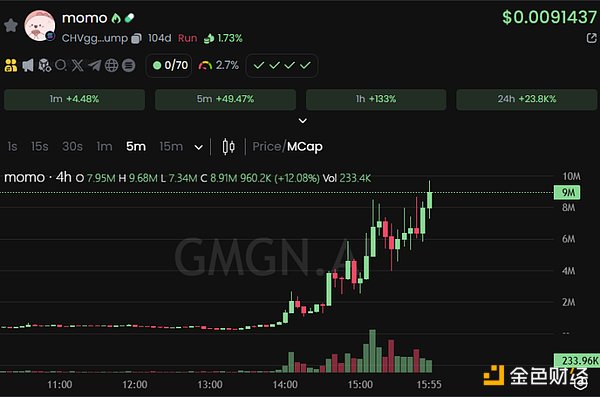
Written by: Pzai, Foresight News
January 19th is the "Tiktok ban" approved by the U.S. Supreme Court As the date of the bill approaches, Xiaohongshu has unexpectedly become a new gathering place for a large number of American users (self-proclaimed “TikTok Refugees”). Following this, MOMO, the MEME token on Solana, surged from the bottom. As of press time, its market value soared from US$100,000 to a market value of nearly 12 million, reflecting the market’s fanatical pursuit. What is MOMO? Why are users flocking to a pink dinosaur avatar?
IdentityThe U.S. Supreme Court announced on January 10 that it would uphold the ban on TikTok. Its parent company ByteDance is required to spin off TikTok before January 19, 2025, otherwise it will face a complete ban. This decision triggered strong dissatisfaction and concern among American users, especially creators and ordinary users who relied on TikTok. They began to look for alternative platforms, and Xiaohongshu became a popular platform for many Americans because of its content format and community atmosphere similar to TikTok. User's first choice. These users created the "TikTokRefugee" tag on Xiaohongshu to share their migration stories and life content. As of January 13, the number of notes under this label has exceeded 84,000, and the total number of views has exceeded 61 million. The download volume of Xiaohongshu also soared to the top of the free list of the US App Store in a short period of time.
This incident also attracted the attention of the encryption circle, and Solana founder Toly retweeted it Xiaohongshu’s relevant tweets reflected the popularity of the incident in the United States. MOMO is one of WeChat's design IPs. When users use WeChat authorization to log in to platforms such as Xiaohongshu, Douban, and Zhihu, if they choose to skip the steps of naming and avatar, WeChat will provide a system default ID and avatar. , and MOMO is one of them.
As more and more users actively choose the nickname "MOMO" and Avatar, which gradually evolved into a synonym for an anonymous group. fromFrom a psychological perspective, this phenomenon reflects the complex mentality of contemporary young people under privacy protection and social pressure. First of all, the choice of anonymous identity may be due to the need for privacy protection to avoid being discovered or tracked by acquaintances, so as to maintain personal privacy in the Internet era where information is highly transparent. This behavior may be an escape from social expectations or a rebellion against the pressure of a unique online identity.
Secondly, choosing "MOMO" may be a way to simplify your identity and reduce the pressure of maintaining a specific online persona across multiple platforms. Users may feel safer to express themselves under the "MOMO" identity and gain a certain degree of psychological safety without worrying about the consequences, which is of great significance to their mental health and online interactions. In addition, as a representative symbol in this hotspot, "MOMO"'s anonymity and meme communication fit perfectly with the values and practices of encryption culture, just as users maintain the privacy and control of their digital identities by choosing "MOMO" generally.
In the previous case, we can see the MEME brought by TikTok The effect is significant. This effect may also be reproduced on Xiaohongshu again, because the spread of MEME often relies on group effects and "herd psychology." As a highly symbolic content form, MEME can quickly convey emotions and opinions while having a low threshold for participation. As a platform based on UGC (user-generated content), Xiaohongshu’s interaction and imitation behavior among users will accelerate the spread of MEME, quickly triggering the participation of more users, forming a snowball effect. And for the Chinese community, the spread of Xiaohongshu MEME is more conducive to user participation, because the cultural barriers of MEME are quickly disappearing, and even impacting the external cultural circle.











